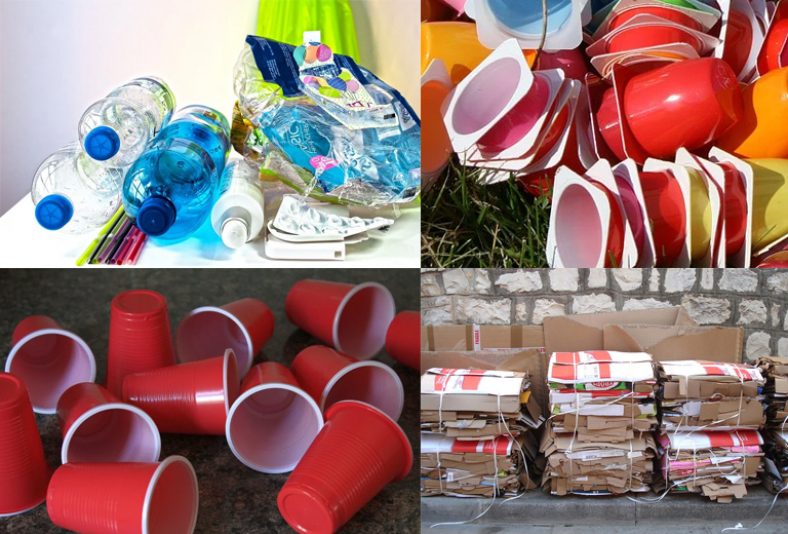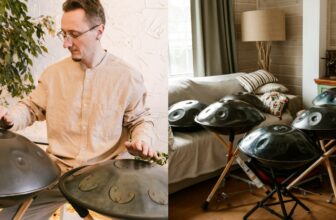How to Make Musical Instruments with Recycled Materials

Making DIY musical instruments with recycled materials can be a fun and easy process. This can also be great for children because it teaches them valuable lessons about reusing and recycling.
In this article, I’m going to show you how to make drums, shakers, tambourines, and string instruments with recycled materials. The beautiful thing about this project is that you will most likely use materials found around the house.
Contents
Drums
Since drumming can be performed on literally anything, making a drum set is one of the easiest tasks when it comes to DIY instruments from recycled materials.
We’re going to start with one drum and you can make several pieces of the same kind.
What you will need:
- An old can (coffee or beans will do)
- A pencil
- A cork cap
- A sharp knife
- A balloon
- 2 barbecue skewers
- Colored paper
- Glue
- Scissors.
Instructions
- Take the knife and cut the cork cap in two halves. Make a hole in each of them so you can stick the skewers in these two pieces of cork. Put some glue into those holes to fix and hold the skewers.
- After that, take the can and the colored paper to mark the lines where you’re going to cut the paper so it can be glued onto the can.
- Cut the paper and decorate the can with the paper.
- Take the balloon and put it on the can.
- Finally, cut a piece of thin rope and glue it on the paper, on the can. This little decoration will make your drum look like a real march drum.
- Now that you’ve finished your first drum, you can make some additional pieces. Use both smaller and larger coffee and bean cans, as well as thinner and thicker balloons. The thickness of the balloons will affect the tone of the drums so take some time to try different variations.
Shakers, maracas, and cymbals
Now that we’ve finished the drum set, it’s time to make some drumming accessories.
Let’s start with a couple of shakers. Modern families produce a lot of plastic waste daily. A large bulk of this waste comes from plastic and glass bottles. The next thing we’re going to do is take the best of the plastic and glass world to make new instruments.
So, take two 0.5L (16 oz.) bottles, remove the labels and wash them with tepid water (the bottles, not the labels). Now take several lids from glass bottles and put them into these plastic bottles. Put the caps on the plastic bottles and, voila, you got yourself a fine set of shakers. You can also embellish them with some colored paper or other colorful objects.
The maracas will be made the same way, the only difference is the type of bottle you’re going to use. Check out here how to make visually attractive and simple maracas:
When it comes to cymbals, you can use two old metal plates. They already possess the quality of producing a metal sound so it’s a perfect DIY instrument for lazy parents. Still, you can decorate them or let your kid do it.
Even if you don’t have them in your house, you can easily get a pair (metal plates, not kids) on Craigslist or any other similar website.
The other solution is to take two old CDs, make a strap and tie it through the holes in the CDs. The kids will be able to hold the CDs by putting their fingers through the straps. While these cymbals won’t produce the “clink” sound, they can still be fun, especially for toddlers. For more information, take a look at this picture!
Tambourine
Another member of the rhythm family, the tambourine is both easily made and played at home.
- What you’re going to need here are two used paper or plastic plates, several jingle bells, a handful of small stones or pebbles, yarn, a pencil, and a knife or a hole puncher.
- Take the plates, put them together and use the pencil to make the marks where you’re going to punch the holes. The distance between every hole should be the same. Also, make sure that the number of holes equals the number of jingle bells.
- Make sure that you also cut an equal number of pieces of yarn that will hold together the plates and the bells.
- When all the marks for the holes have been made, take the hole puncher and make the holes.
- Then take the bells and the pieces of yarn and tie the bells to the plates. Before you tie the last piece of yarn, put the pebbles into the tambourine. Make sure that all the jingle bells are firmly attached to the plates, decorate them and you got yourself a nice and practical tambourine.
For more details, have a look at this video:
String instruments
This segment is called String instruments because they’ll neither be guitars nor pianos, but inbetweeners. Let’s face it, it’s pretty demanding to make the guitar in its full shape at home. The string instruments we’re going to manufacture will function just like a guitar, with a slightly different appearance.
Preparations and equipment:
Firstly, go to the local store and get a set of elastic bands. It would be perfect if you could get six bands of different widths so that each of them represents one guitar string.
While you’re already outside, get a few boxes of the same size; shoe boxes will do. Ask the shop assistant at the local store if they can give it to you for free. You’ll also need a sharp knife, a pencil, scissors, duct tape, and glue.
Creative process:
- Take the box lid and a pencil and draw a line on the box where the sound hole will be. Cut that part out and put the lid aside.
- Also, make six small holes below the sound hole for elastic bands. Now get another box and cut out two smaller parts of the cardboard and make six holes in each of them. This is where the elastic bands will be attached.
- The next thing you should do is paint or decorate the guitar. A bit older kids will probably enjoy doing this, especially if they already have their guitar heroes. If so, let them choose the decorations for this guitar.
- When the paint and glue are dry, you can glue the two parts of the elastic bands to the box lid. These bands must be tense to produce tones. Once you’ve attached the bands, use the duct tape to unite the box lid and the box.
- If you want to, you can add a cardboard tube to this box, such as a neck. That way, it will look more like a guitar. If not, it will be something between a harp and a guitar. Either way, your kids should have great fun using this instrument.
Paper Flute
This one is probably one of the easiest instruments you can make by just using paper, scissors, and a few elastic bands. In just a few simple steps, you can make a fully functional paper flute.
What you will need:
- Two sheets of paper
- Elastic bands
- Scissors
Instructions:
- Roll the two sheets of paper together. Using some thick paper would be better instead of using some regular and really thin paper.
- Put two elastic bands on each end to hold the paper just a few inches from the top and the bottom.
- Next, you need to cut a hole at the ‘top’ end (whichever end you choose) just before the elastic band that will function as the main sound hole.
- On the ‘top’ end, you need to pull one sheet of paper slightly down so that the air can travel through both sheets of paper. You can do this with scissors.
- Lastly, you can cut small holes along the flute (not too many) so that you can change notes.
Note: It might take some fiddling around, especially with folding the one sheet of paper for the air hole in order for the air to come through and produce a sound.
Pan Flute
Making a pan flute is also fairly simple and requires regular items from around the house. The process shouldn’t take more than 30 minutes and you can also tune it to your liking.
What you will need:
- Scissors
- Straws (wide ones, not regular ones)
- Aluminum foil
- Hot glue gun
Instructions:
- Use the glue gun to put some glue on the foil (as shown in the video).
- Take a straw and dip it in the glue when it cools slightly and let it settle. Afterward, remove the straw from the foil so that the air hole is sealed. You can also peel off the glue that remains around the ring.
- Do this with other straws. However, to get different notes, you need to cut the straws a bit shorter than the first one. (You could use a tuner APP to pinpoint the note you want).
- Lastly, tape the straws together, and there you have it.
Conclusion
These are only several suggestions for DIY home instruments made from recycled materials. If you have enough time and energy, you can make dozens of other instruments or musical accessories with your kids. Making these instruments with you will raise their awareness of ecological issues, spark their interest in music and give them a great time with their parents. For all these reasons, wait no more but get down to work and show some creativity.





